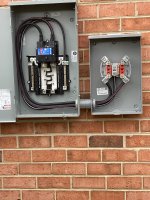You are using an out of date browser. It may not display this or other websites correctly.
You should upgrade or use an alternative browser.
You should upgrade or use an alternative browser.
Aluminum wire
- Thread starter jeramiepluemer
- Start date
- Status
- Not open for further replies.
- Location
- Illinois
- Occupation
- retired electrician
I should have said that the aluminum oxide forms instantly when the aluminum is exposed to oxygen. If you brush the conductor after the anti-oxidant is applied the aluminum is not exposed to oxygen and the oxide does not reform.If aluminum oxide forms immediately then won't it form after brushing? Most of this stuff seems like nonsense to me. If you don't use antioxidants then don't bother brushing?
- Location
- Illinois
- Occupation
- retired electrician
Have never seen that instruction.I think the wire brushing also serves the purpose of "working" the paste among the stranding. My understanding is the oxide layer is very brittle and the tightening of the joint will easily break through it. Supposedly, according to what the manufacturers say, there are other purposes for the deox besides preventing oxidation. It has zinc particles which improve joint strength and pierce through any oxide layer. Also It provides inter strand conductivity paths which improve overall joint conductivity.
Finally, I know the oxide layer forms quickly, but I would not say instantly. Some instructions I see say to wire brush before applying deox.
How quickly does aluminum oxide form?
Basically the natural aluminum oxide film is composed of two layers, one internal layer composed entirely by Al2O3, with 3–4 nm in thickness and formed within few milliseconds, and a second layer developed by the reaction with molecules in the environment (McCafferty, 2010; Vargel, 2004).
electrofelon
Senior Member
- Location
- Cherry Valley NY, Seattle, WA
- Occupation
- Electrician
That instruction is found on cooper MV load break elbows. The connector comes prefilled with deox, and it says to wire brush the conductor and then put on the connector.Have never seen that instruction.
How quickly does aluminum oxide form?
Basically the natural aluminum oxide film is composed of two layers, one internal layer composed entirely by Al2O3, with 3–4 nm in thickness and formed within few milliseconds, and a second layer developed by the reaction with molecules in the environment (McCafferty, 2010; Vargel, 2004).
- Location
- Illinois
- Occupation
- retired electrician
I guess with a prefilled connector you don't have much of a choice. Haven't done a load break elbow in a very long time, so I don't remember what we did with them.That instruction is found on cooper MV load break elbows. The connector comes prefilled with deox, and it says to wire brush the conductor and then put on the connector.
electrofelon
Senior Member
- Location
- Cherry Valley NY, Seattle, WA
- Occupation
- Electrician
I watched a couple YouTube videos on elbow installation, one by a lineman college and one by Eaton, and in both of them they wire brushed the connector and then put the copper top connector on. The Eaton video did say to immediately put on the connector after wire brushing.I guess with a prefilled connector you don't have much of a choice. Haven't done a load break elbow in a very long time, so I don't remember what we did with them.
I don't have a strong opinion on any of this, I'm just pointing out the lack of consistency in these various instructions.
letgomywago
Senior Member
- Location
- Washington state and Oregon coast
- Occupation
- residential electrician
I have something to chime into this. Have you ever looked at how knarlly the aluminum is after using a mechanical connector. The screw bites in hard so if you use antioxidant goop on it and then bite down the screw it will cause some fresh AL free of oxygen to make contact with the lug. This doesn't work for crimps and other types of connections but I think in mechanical lugs it does make a difference. Side note too is that having the goop on there prevents direct contact to the air and moisture so this would prevent it from forming a battery and oxidizing faster.
LarryFine
Master Electrician Electric Contractor Richmond VA
- Location
- Henrico County, VA
- Occupation
- Electrical Contractor
I watched the POCO land the line conductors in a meter base I installed on a new house I wired.
The guy placed a blob of compound about the size of a large green pea in the terminal and laid the un-brushed aluminum wire in it.
The guy placed a blob of compound about the size of a large green pea in the terminal and laid the un-brushed aluminum wire in it.
letgomywago
Senior Member
- Location
- Washington state and Oregon coast
- Occupation
- residential electrician
Sounds like a polaris connectorI watched the POCO land the line conductors in a meter base I installed on a new house I wired.
The guy placed a blob of compound about the size of a large green pea in the terminal and laid the un-brushed aluminum wire in it.
electrofelon
Senior Member
- Location
- Cherry Valley NY, Seattle, WA
- Occupation
- Electrician
I tried to pull up instructions for those to see if they said anything about wire brushing, but I couldn't find any instructions online.Sounds like a polaris connector
LarryFine
Master Electrician Electric Contractor Richmond VA
- Location
- Henrico County, VA
- Occupation
- Electrical Contractor
letgomywago
Senior Member
- Location
- Washington state and Oregon coast
- Occupation
- residential electrician
I mean that polaris connectors come with a pea sized dab in them already. It's not the entire wire surface.No, regular meter lay-in terminal with the slide-in insert, like this one:
(This is my work. The GECs and inspection and energizing are done.)
View attachment 2570248
- Location
- New Jersey
- Occupation
- Journeyman Electrician (retired)
The thing I don't get is that if the condcutors oxidize after you remove the insulation then when isn't antioxidant paste always required? I thought that with the newer allows none of this matters. You strip the conductor and insert it into the terminal and tighten. What am I missing?
I remember when the lay in terminals in meter pans had the stuff in there from the factory but the last one I installed had nothing.
I remember when the lay in terminals in meter pans had the stuff in there from the factory but the last one I installed had nothing.
Fred B
Senior Member
- Location
- Upstate, NY
- Occupation
- Electrician
The almost instantaneous oxidation was an issue with the old AL wire. The new AA8000 AL will not oxide that quick nor form the skin effect common with the old AL. Seen the old stuff, almost as soon as the insulation is removed you'll start getting a white film forming, the new stuff i've gone back days later and still nothing obvious present.Because you are not doing anything to break up the aluminum oxide on the surface of the conductor. That is the only purpose of the wire brushing, and since aluminum oxide forms instantaneously, you have to break it after you have applied the anti-oxidant.
kwired
Electron manager
- Location
- NE Nebraska
- Occupation
- EC
It is almost the same thing especially should the Noalox happen to be listed yet there is no requirement to use such compounds on conductors we have been using for 35 plus years.I seem to recall getting scolded by an inspector for using the wrong staples on MC. I was using 1/2 Staples usually used for nm, he wanted the 9/16 ones. I said this wood was hard and the 9/16 ones just bend over, so the 1/2 ones are more appropriate in this case.
But that's all a little different. That's a case of where a support or securement is required but the components are not required to be listed. For the Noalox, there's no requirement to use it at all.
If you happen to encounter older alloys you possibly do still need to use it
kwired
Electron manager
- Location
- NE Nebraska
- Occupation
- EC
How about using a shield gas while terminating like welders do in many circumstancesI think the wire brushing also serves the purpose of "working" the paste among the stranding. My understanding is the oxide layer is very brittle and the tightening of the joint will easily break through it. Supposedly, according to what the manufacturers say, there are other purposes for the deox besides preventing oxidation. It has zinc particles which improve joint strength and pierce through any oxide layer. Also It provides inter strand conductivity paths which improve overall joint conductivity.
Finally, I know the oxide layer forms quickly, but I would not say instantly. Some instructions I see say to wire brush before applying deox.
kwired
Electron manager
- Location
- NE Nebraska
- Occupation
- EC
I've never seen meter terminals pre applied with it. What kind were you seeing this with?The thing I don't get is that if the condcutors oxidize after you remove the insulation then when isn't antioxidant paste always required? I thought that with the newer allows none of this matters. You strip the conductor and insert it into the terminal and tighten. What am I missing?
I remember when the lay in terminals in meter pans had the stuff in there from the factory but the last one I installed had nothing.
- Location
- New Jersey
- Occupation
- Journeyman Electrician (retired)
Standard 200 amp meter pan like Larry posted a photo of.I've never seen meter terminals pre applied with it. What kind were you seeing this with?
kwired
Electron manager
- Location
- NE Nebraska
- Occupation
- EC
Specific brand, model or specification? Like I said I've never seen that. I could see some POCO's that have approved meter list or even ones that supply meters to the customer/contractor may specify this or even apply the compound after they receive them.Standard 200 amp meter pan like Larry posted a photo of.
- Location
- Illinois
- Occupation
- retired electrician
It actually does work for crimps as the aluminum oxide is very brittle and shatters when you make the crimp. The connection points in a crimp connector are considered gas tight so the oxide will not reform.I have something to chime into this. Have you ever looked at how knarlly the aluminum is after using a mechanical connector. The screw bites in hard so if you use antioxidant goop on it and then bite down the screw it will cause some fresh AL free of oxygen to make contact with the lug. This doesn't work for crimps and other types of connections but I think in mechanical lugs it does make a difference. Side note too is that having the goop on there prevents direct contact to the air and moisture so this would prevent it from forming a battery and oxidizing faster.
- Status
- Not open for further replies.


